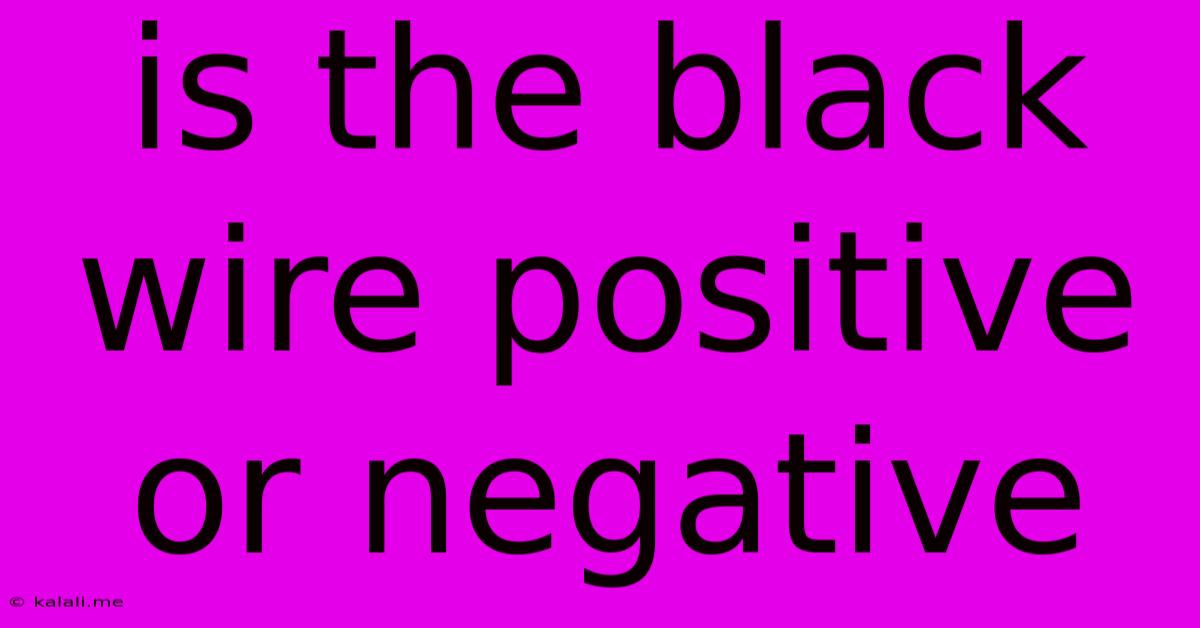Is The Black Wire Positive Or Negative
Kalali
Jun 06, 2025 · 3 min read

Table of Contents
Is the Black Wire Positive or Negative? Decoding Wire Color Codes
Determining whether a black wire is positive or negative depends entirely on the context. There's no universal standard assigning black to a specific polarity. This article will explore various situations where you might encounter black wires and how to safely identify their function. Understanding wire color codes is crucial for safe electrical work; always prioritize safety and, if unsure, consult a qualified electrician.
Why There's No Single Answer
Unlike some wires where color coding is more standardized (like red for positive in many automotive applications), black wire usage varies widely across different systems and applications. This ambiguity highlights the importance of checking schematics or using a multimeter to confirm polarity.
Common Scenarios and Their Color Codes
Here are some examples where you might find black wires and how their polarity is determined:
1. Household Wiring (North America):
- Black: Typically represents the hot wire (live, carrying current), which is considered positive in a DC circuit or the energized conductor in an AC circuit.
- White: Represents the neutral wire, which is the return path for current.
- Green or Bare Copper: Represents the ground wire, providing a safety path for stray current.
Important Note: While black is commonly hot in North American household wiring, always verify with a circuit tester or multimeter before making any assumptions. Wiring configurations can vary.
2. Automotive Wiring:
Automotive wiring color codes are less standardized than household wiring. Black wires can represent:
- Ground: Common in many automotive systems.
- Negative: In some specific circuits.
- Other Functions: Depending on the manufacturer and specific application.
Always consult your vehicle's wiring diagram for precise information.
3. Electronics and Appliances:
In electronic devices and appliances, black wires can serve various purposes, including:
- Ground: A common use, especially in equipment that requires grounding for safety.
- Negative: In DC circuits, black may represent the negative terminal.
- Specific Circuit Functions: The function will be documented in the device's schematics or service manual.
4. Other Applications:
Numerous other applications use black wires without a consistent polarity standard. These include industrial control systems, audio equipment, and specialized electronic devices. Always refer to the relevant documentation for that specific system.
How to Identify Polarity Safely
Never assume the function of a wire based on color alone. Use the following methods to determine polarity accurately and safely:
- Wiring Diagrams/Schematics: Always consult the wiring diagram for the specific system.
- Multimeter: A multimeter is the safest and most reliable tool for testing voltage and current, allowing you to determine the polarity of the black wire in any given circuit.
- Circuit Tester: A non-contact voltage tester can help identify live wires, but it won't determine polarity.
Conclusion:
The question "Is the black wire positive or negative?" doesn't have a simple answer. Black wire usage varies significantly based on the system or application. Always prioritize safety and verify the function of any wire before working with it using appropriate testing tools and consulting relevant documentation. Improper identification can lead to electrical shock or damage to equipment. When in doubt, consult a qualified electrician.
Latest Posts
Latest Posts
-
What Does Curie Like Fallout 4
Jun 07, 2025
-
Code First Approach Vs Database First Approach Which Is Best
Jun 07, 2025
-
How To Keep Pipes From Freezing In Exterior Wall
Jun 07, 2025
-
Can I Look At My Deltedreminders On Mac
Jun 07, 2025
-
Limit Fram Rate On Mac Chrome
Jun 07, 2025
Related Post
Thank you for visiting our website which covers about Is The Black Wire Positive Or Negative . We hope the information provided has been useful to you. Feel free to contact us if you have any questions or need further assistance. See you next time and don't miss to bookmark.